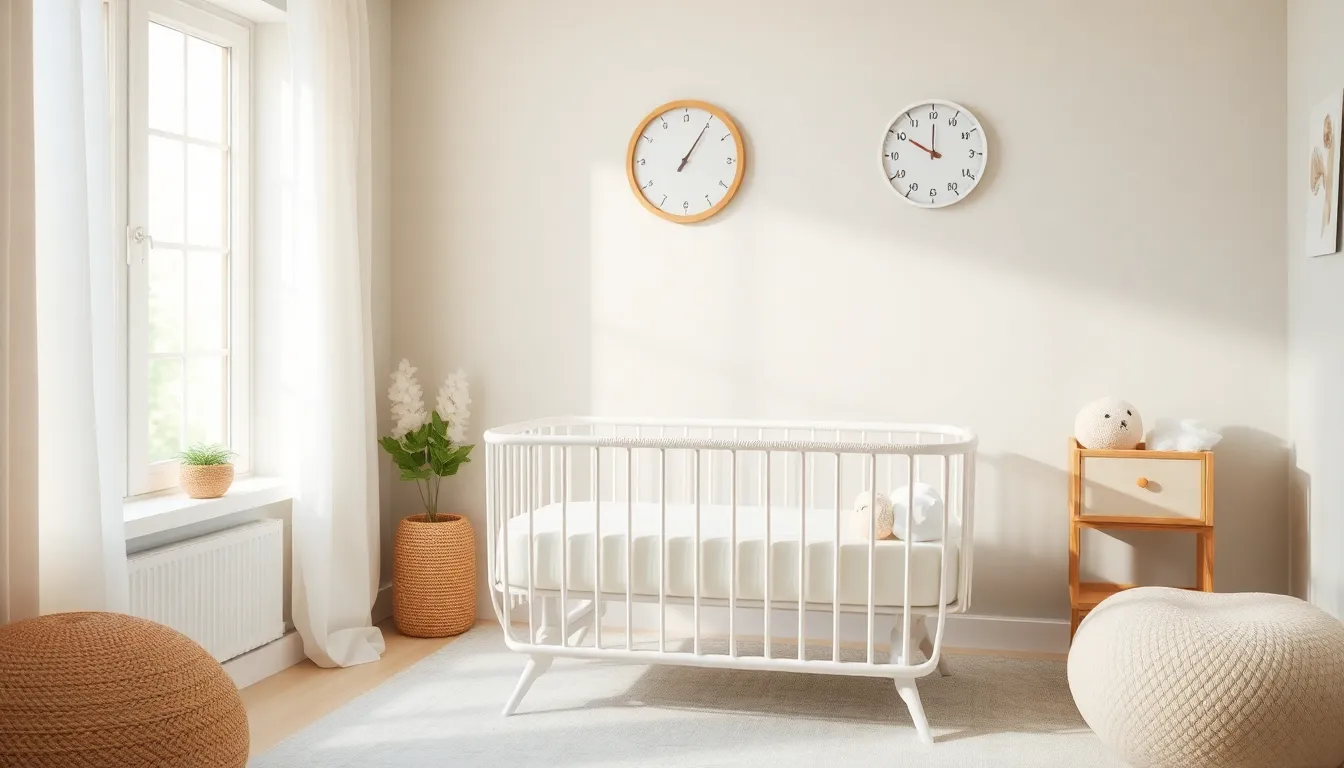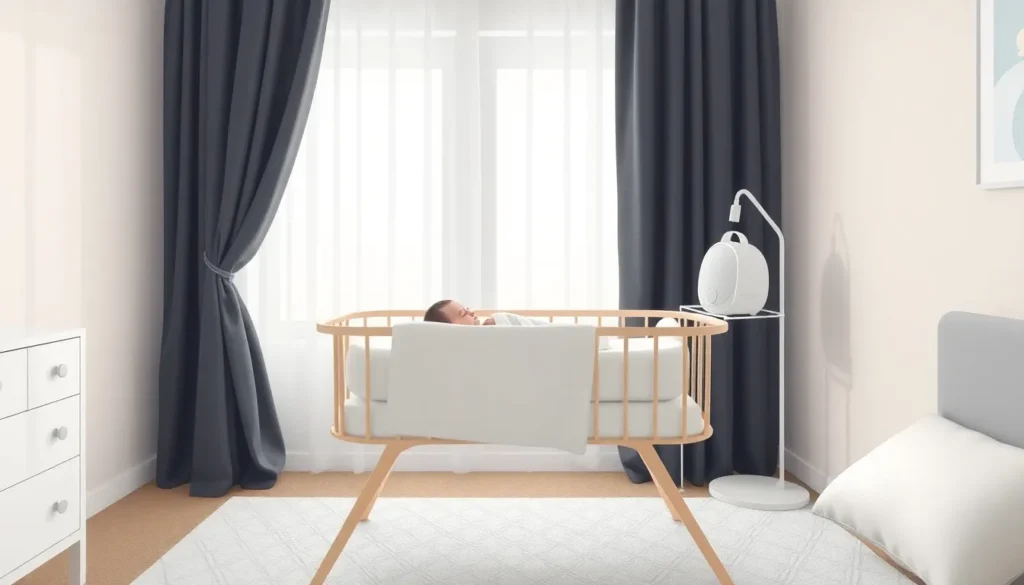Getting a baby to sleep in a bassinet can feel like a game of musical chairs—only the music never stops and the chairs keep disappearing. New parents often find themselves in a whirlwind of sleepless nights and desperate measures. But fear not! With a few clever tips and a sprinkle of patience, they can transform that bassinet into a cozy sleep haven.
Table of Contents
ToggleTips to Get Baby to Sleep in Bassinet
Creating an ideal sleep environment in the bassinet enhances the chances of a peaceful night. Ensure the bassinet is free of clutter. Use a fitted sheet that offers comfort while maintaining safety. Babies respond well to a dark, quiet setting, so consider blackout curtains or a white noise machine.
Swaddling the baby can create a womb-like feeling. This technique provides security and warmth, essential for sleep. Propping the bassinet near the parent’s bed increases reassurance. Having the baby close allows for easier soothing if sleep disturbances occur.
Establishing a consistent bedtime routine promotes positive sleep associations. Activities like gentle rocking, soft singing, or reading a bedtime story signal to the baby that it is time to wind down. Repeating these activities nightly builds predictability and security around sleep.
Feeding the baby right before placing them in the bassinet can also help. A full belly often leads to longer sleep stretches. Observing wake windows is crucial for avoiding overtiredness. Each baby has unique sleep needs—watch for signs of drowsiness and lay them down when they signal readiness.
Try maintaining comfortable room temperatures. Keeping the room between 68°F and 72°F ensures that the baby stays snug. Additionally, regularly check the baby’s comfort and adjust blankets if necessary. Comfort plays a significant role in encouraging sleep.
Consider incorporating a gentle rocking motion to soothe the baby into slumber. Natural movements mimic the sensations experienced in utero. Lastly, patience remains vital. Every baby has their own sleep patterns. Consistency and nurturing support foster long-term sleep success.
Create a Comfortable Sleep Environment

Creating a comfortable sleep environment plays a crucial role in helping babies settle in their bassinets. Consider the following aspects for a soothing atmosphere.
Choosing the Right Bassinet
Selecting the right bassinet ensures the baby has a secure and cozy space. Look for models that meet safety standards, featuring firm mattresses and a stable base. Choose a bassinet that fits the baby’s needs. Portable options offer flexibility, while stationary models provide a fixed sleeping area. Adding breathable fabrics helps regulate temperature and promotes comfort. Avoid pillows and soft bedding, as they pose suffocation risks. Parents can check online reviews or ask for recommendations to find reliable bassinets that suit their lifestyles.
Adjusting Room Temperature
Maintaining an optimal room temperature contributes to a restful sleep. Experts recommend keeping the nursery between 68°F and 72°F. A cooler environment promotes better sleep, while overheating can disturb it. Use a reliable thermometer to monitor the temperature accurately. Parents can adjust heating or cooling systems as needed. Employing light blankets allows for warmth without overheating. Dress the baby in lightweight clothing for a comfortable sleep. Closing curtains during the day can also help keep the room cool, creating a peaceful atmosphere conducive to napping and nighttime rest.
Establish a Bedtime Routine
A consistent bedtime routine helps signal to a baby that sleep time is approaching. Establishing this routine involves a few simple yet effective activities that set the stage for restful sleep.
Activities to Include
Start with calming activities such as a warm bath, which relaxes the baby. Incorporate gentle massage, promoting a sense of security and comfort. Reading a soothing bedtime story can also be beneficial; choose books with rhythmic language. Singing a lullaby reassures the baby, creating a peaceful atmosphere. Dim the lights during these activities to enhance the sleep environment. Offering a final feeding right before laying the baby down establishes a strong association with sleep.
Consistency is Key
Consistency reinforces the bedtime routine’s effectiveness. Implement the same sequence of activities each night, ideally around the same time. Babies thrive on predictability, so keeping the routine unchanged helps them know what to expect. Familiar scents from sleepwear can provide additional comfort. Sticking to the routine, even during weekends or outings, strengthens sleep associations. Gradually, the baby learns to relax and transition into sleep more easily.
Soothe Your Baby Effectively
Soothe your baby with calming techniques to promote better sleep in the bassinet. These methods address common sleep challenges while creating a serene sleep environment.
Swaddling Techniques
Swaddling enhances a baby’s sense of security and comfort. Start with a lightweight, breathable blanket. Wrap the baby snugly, leaving enough room for the legs to move freely. Create a pocket at the bottom to keep the feet secure. Secure the arms close to the body to mimic the womb feeling. Monitor the baby’s temperature for comfort and always place them on their back to sleep. Adjust the swaddle as needed based on the baby’s reactions to avoid overstimulation.
Using White Noise
White noise helps mask external sounds that may disturb a baby’s sleep. Consider a white noise machine or a smartphone app. Play soothing sounds like rainfall or gentle waves to create a calming atmosphere. Position the device safely away from the bassinet to avoid any risks. Maintain a consistent volume, neither too loud nor too soft, to ensure effectiveness. Using white noise can guide your baby into a deeper sleep, fostering a more peaceful environment for both baby and parents.
Monitor Sleep Cues
Recognizing sleep cues plays a vital role in helping a baby settle into a bassinet. Observing signs like yawning, rubbing eyes, or fussiness can indicate that it’s time for sleep. Responding promptly when these cues appear helps prevent the baby from becoming overtired.
Noticing a baby’s alertness can guide parents on when to initiate bedtime routines. Keeping a close eye on the baby’s wake windows, which typically range from 45 minutes to 2 hours for newborns, informs parents about optimal sleep times. Understanding individual patterns, like when a baby tends to be more irritable, aids in developing a responsive sleep schedule.
Watching for changes in the baby’s state can improve sleep quality. If they appear restless or start to cry, addressing their needs quickly can help. Whether it’s adjusting swaddles or soothing them with gentle pats, these actions contribute to a smoother transition into sleep.
Timing also plays a significant part in achieving successful sleep. Noticing the rhythm of a baby’s cycles, such as when they seem to rouse after a sleep period, helps parents respond effectively. Adjusting the sleep environment according to these cues, like dimming lights or turning on white noise, enhances comfort.
Becoming attuned to these signals fosters a strong parent-baby connection. Acknowledging and following cues builds trust and security, making it easier for the baby to feel safe in the bassinet. Taking the time to learn these cues benefits both the baby’s sleep journey and the overall parenting experience.
Getting a baby to sleep in a bassinet can be a challenging journey for new parents. By implementing these practical tips and creating a nurturing environment, parents can significantly improve their baby’s sleep experience. Consistency in routines and attention to sleep cues play vital roles in promoting restful nights.
It’s essential to remember that every baby is unique and may require different approaches. Patience is key as parents navigate this phase. With time and dedication, they’ll find the right balance that fosters a peaceful sleep atmosphere for both the baby and themselves. Embracing these strategies can lead to more enjoyable and restful nights ahead.





